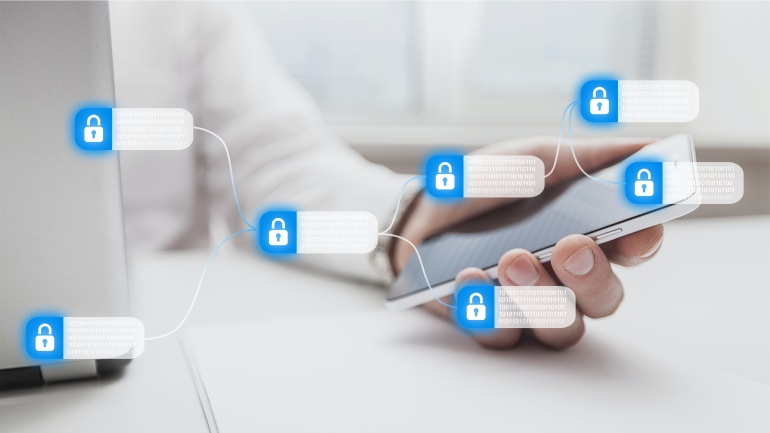Maintaining an edge over competition, staying on track with ever-shifting customer needs and seeing steady revenue growth, can be hard in the fiercely competitive environment of telecoms. That is why the telecom industry needs to consider introducing new technologies into their business practices. One such promising technology that can give telecommunications business owners leverage in the industry is blockchain.
Blockchain was created as a technology that brings trust where it does not exist. Currently, the telecommunications blockchain market is in its early stages, with only a few vendors having launched telecommunications blockchain solutions. Given the complex nature of blockchain and distributed ledger technology, it is clear that in order for it to succeed in the telecommunications industry, vendors will need to pool their knowledge of blockchain technology and the telecommunications industry.
Bringing blockchain into play can create significant benefits and opportunities for a variety of telecommunications sectors. Some of these include advancement in support, internal and external operations, new sources of revenue, enhanced corporate cyber security and more. However, to fully appreciate the value of this technology, you first have to understand it.
What is blockchain?
Blockchain is a distributed ledger database technology that allows users to share data using a consensus mechanism without the need for a centralized authority. Blockchain is the core technology of Bitcoin. This is a way to have “blocks” of encrypted data “chained” together to ensure that the data cannot be altered after it has been recorded.
At a basic level, a blockchain is a chain of blocks, but not in the traditional sense of the word. When the words “block” and “chain” are used in this context, it means that the digital information (“block”) is stored in a public database (“chain”). Simply put, a blockchain is a database that is shared across multiple computer networks. Once a record is added to a chain, it is very difficult to change it. The network makes checks regularly to ensure that all copies of the database are identical.
Each block contains a unique code called a hash. It also contains the hash of the previous block in the chain. This hashcode is generated by a mathematical function. It takes digital information and generates a thread of letters and numbers from it. The two important hash features are: first, regardless of the size of the original file, the hash function will always generate code of the same length. Second, any change to the original input will create a new hash. So, if someone decided to delete a single symbol from the information on the block, it would show up because the hash would change. As the next block in the chain still has the old hash, the hacker would have to recalculate it to restore the chain. As well as the next one, and so on.
Converting all those hashes would require a tremendous amount of computing power. Each computer on the blockchain network has its own copy of the blockchain. This means that there are thousands and in some cases millions of copies of the same blockchain. Therefore, the blockchain is said to be the most secure transactional system in the world.
In general, blockchain technology is considered more than complex. But what more could be expected from a technology that is revolutionizing the world? Now, let us look at what kind of benefits and capabilities blockchain can bring to the telecommunications sector.
Benefits and capabilities of blockchain
Smart contracts
Blockchain and smart contracts can automate a lot of internal processes such as billing, roaming and supply chain management. A smart contract is a protocol used to facilitate and verify contract negotiations. Like a physical contract, a smart contract defines the regulations and sanctions of the agreement but can also enforce them automatically. Because smart contracts have predefined conditions, the contract is automatically performed only when the conditions are fully met. The use of smart contracts allows telecom entrepreneurs to ultimately reduce costs and benefit from the convenience of the automation factor.
Secure identity verifications
Because blockchain technology offers a reliable and unbeatable level of security, digital ID authentication will be one of most valuable applications in the telecommunications industry. Currently, every time a person wants to sign up with a seller, they have to prove their identity and credentials using physical or digital documents. By using a blockchain, a person would provide their PII (Personal Identifiable Information), which is stored in a blockchain. The telco could participate in blockchain-managed identity management functions for its services, as well as offer this function as a service to its partners. On the blockchain network, authentication could be applied to all devices, applications and organizations that need to verify identity documents, such as passports, driver’s licenses and birth certificates, to list just a few.
Fraud prevention
Fraud detection and prevention continue to be topics of relevance for most CSPs. Fraud cost the industry $28.3 billion in 2019, according to the Communications Fraud Control Association’s (CFCA) survey. Blockchain-based solutions could be implemented to minimize identity, roaming and SIM swap fraud.
Blockchain offers solutions to combat the plague of identity theft. It allows users to better control their data by creating a self-contained digital identity. Blockchain can help to protect private information that is heavily encrypted by the private key. The private key is associated with only one device, so the probability of data theft is dramatically reduced.
Roaming fraud can be mitigated by implementing a licensed blockchain between each pair of roaming operators. This solution includes smart contracts that govern transactions between a CSP acting as a home operator and roaming partners, in order to monitor users’ online activities. Each time a subscriber activates an event on a visited network, a smart contract would be executed if the terms of the roaming partner contract are met.
SIM swap fraud occurs when a cybercriminal tricks his victim’s mobile phone service provider into porting the victim’s phone number to a new SIM card inserted into a device controlled by the hacker. As a result of the SIM change, the real customer’s mobile phone is disconnected from the mobile network and that subscriber does not receive any services, including critically important two-factor authentication SMS alerts. With the blockchain, the porting of a number could only be instigated and approved by the owner of that number via the blockchain, using his private key.
Number portability
Two other common challenges for telecommunication providers are the uninterrupted porting of numbers across multiple operators, and compliance with regulatory requirements. Again, the blocking chain can be used by CPSs to address these issues. The solution includes smart contracts that regulate transactions between users, the “donor” service provider, and the “recipient” service provider under a mobile number portability scenario.
As all the phone numbers would be managed in one decentralized ledger. This architecture would provide standardized access and routing lookup for all operators on a global basis. This solution also provides the regulator with visibility of the process. The smart contract is subject to rules and parameters set by the regulator in each market. Porting using blockchain technology would improve the customer experience, reduce regulatory and business costs. It would also allow for better management of fraud, spoofing and identity theft.
To learn more about blockchain capabilities as related to number portability, read this article.
Data integrity protection
Data integrity refers to the reliability and dependability of data. This includes maintaining and ensuring the accuracy and consistency of data throughout its existence. Blockchain may be the solution to allow data integrity to reach the highest standards. By design, blockchains are inherently resistant to the modification of data. Blockchain ledgers are immutable, meaning that if data has been added to the blockchain, then that data cannot be edited or deleted. The data is part of the blockchain, and will remain so. In addition, blockchains are not only a data structure but also a timekeeping mechanism for the data structure. This means that the history of data is easily reportable and updated to the second.
Conclusion
To sum up, the use of blockchain can make an enormous contribution to the telecommunications industry. Adopting blockchain to enhance efficiency, build trust and improve transparency can help the telecommunication providers deliver a faster and more reliable service that is highly valued by customers. Because blockchain technology is still considered relatively new, there are many more possibilities and use-cases that are still unfolding.







